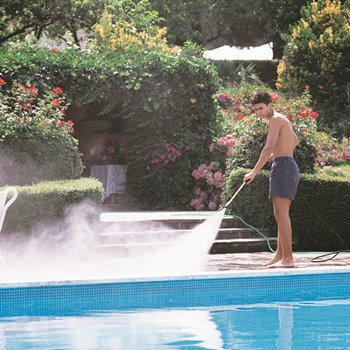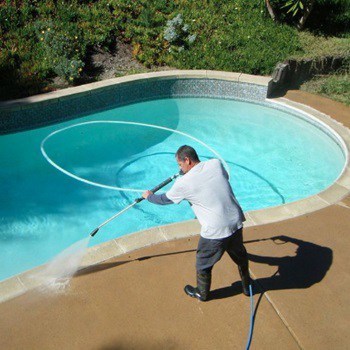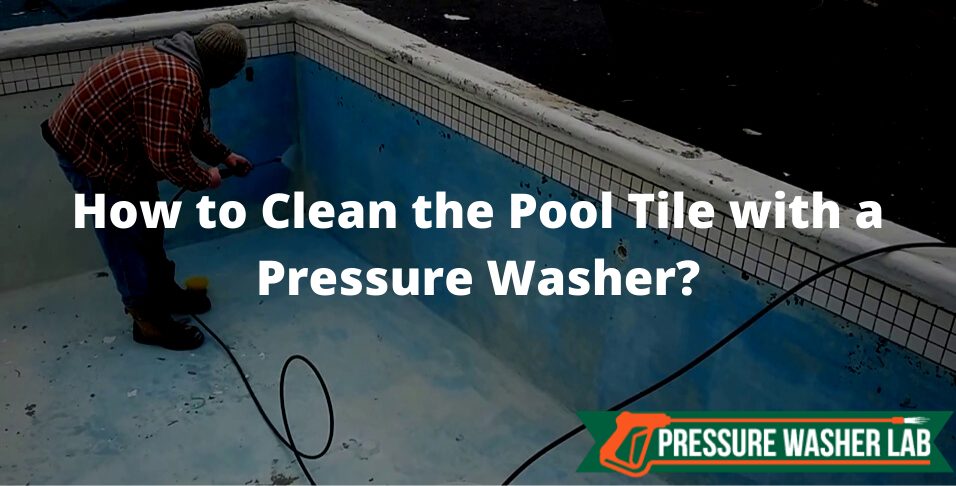Cleaning the pool tiles with a pressure washer requires using a PSI between 2000 and 2600, splitting the pool into smaller sanitation sections, and following safety measures such as wearing protective clothing. Before pressure washing pool tiles, the water should be drained out of the basin, and the pressure of the unit should be tested on a small area.
When cleaning pool tiles with a pressure washer, the main focus should be on the parts that have calcium buildup, which can be removed using salt or soda blasting. Cleansing the pool tiles using a steam pressure washer that can heat the water to about 300 degrees is also recommended.
Pressure washing pool tiles using a 3000 PSI should be done rarely and only by moving further away from the tiles in order to avoid damage. While using an electric pressure washer to clean pool tiles, the wires have to be protected from getting wet. The steps for pressure washing the pool tiles are discussed in detail below.
Is It Safe to Pressure Wash Tiles?
 It is safe to pressure wash tiles if the water pressure applied doesn’t exceed 3,000 PSI. The safest way to pressure wash pool tiles is to start with 2,000 PSI and gradually increase pressure to 2,500 PSI. Using a commercial pressure washer rated at 4,000 PSI can weaken the grout or make the pool tiles more susceptible to breaking. Using detergents for pressure washing pool tiles is not safe since detergents can leave residue, mix with water, and make swimming in the water dangerous.
It is safe to pressure wash tiles if the water pressure applied doesn’t exceed 3,000 PSI. The safest way to pressure wash pool tiles is to start with 2,000 PSI and gradually increase pressure to 2,500 PSI. Using a commercial pressure washer rated at 4,000 PSI can weaken the grout or make the pool tiles more susceptible to breaking. Using detergents for pressure washing pool tiles is not safe since detergents can leave residue, mix with water, and make swimming in the water dangerous.
How to Use the Pressure Washer to Clean the Pool?
The steps on how to use the pressure washer to clean the pool are listed below:
1. Get the Right Pressure Washer
Using a steam pressure washer for cleaning the pool tile is recommended when detergents are not used. A steam pressure washer that can deliver water at 300 or more degrees will sanitize the pool and remove germs and bacteria.
2. Clear the Pool
Empty the pool and remove all the debris from the bottom to be able to wash the tiles or use a waterproof pressure washer to clean the pool without draining it.
3. Get the Right Pressure
Start the pressure washer and reach 2,000 PSI, then adjust and increase the pressure while ensuring the pressure is not damaging the tiles or the grout.
4. Separate the Cleaning in Sections
The pool tiles should be pressure washed in sections – several rows of tiles at a time.
5. Maintain the Right Distance
A distance of around 3 feet or more should be held when pressure washing pool tiles, depending on the pressure washer nozzle used. A pressure washer gun can ensure that a sufficient distance is kept and facilitate cleaning hard-to-reach spots.
6. Attach the Right Nozzle
Low-pressure nozzles such as a 25 or 45-degree nozzle should be used for pressure washing pool tiles.
FAQ
1. Will a pressure washer remove calcium deposits from the pool tile?
 Yes, a pressure washer rated at 2,000 PSI and higher can remove calcium deposits from the pool tile. Using high-pressure spray nozzles or a turbo nozzle at a distance of 3.5 feet can remove calcium and other deposits from the pool tile.
Yes, a pressure washer rated at 2,000 PSI and higher can remove calcium deposits from the pool tile. Using high-pressure spray nozzles or a turbo nozzle at a distance of 3.5 feet can remove calcium and other deposits from the pool tile.
2. Do you have to drain the pool during pressure washing?
No, the pool doesn’t have to be drained during pressure washing or it can be partially drained to a level of 8 to 9 inches.
3. How to clean the pool tile with a pressure washer without draining the pool?
To clean the pool tile with a pressure washer without draining the pool, use high pressure, yet not higher than 3,000 PSI, to wet calcium deposits. Use a pumice stone or a scrubber to scrub the deposits, then pressure wash the tiles again.
4. How to clean pool tiles with vinegar?
To clean pool tiles with vinegar, mix some distilled vinegar with water, feed the pressure washer with it, spray it over calcium deposits and stains, scrub the area, then rinse the tiles with water.

